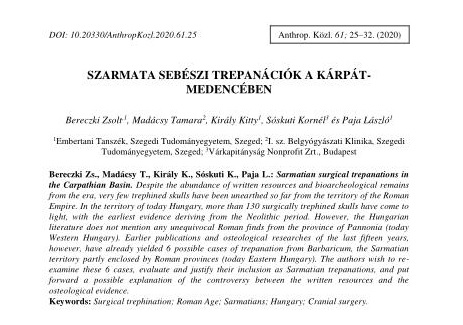Szarmata sebészi trepanációk a Kárpát-medencében
Absztrakt
Despite the abundance of written resources and bioarcheological remains from the era, very few trephined skulls have been unearthed so far from the territory of the Roman Empire. In the territory of today Hungary, more than 130 surgically trephined skulls have come to light, with the earliest evidence deriving from the Neolithic period. However, the Hungarian literature does not mention any unequivocal Roman finds from the province of Pannonia (today Western Hungary). Earlier publications and osteological researches of the last fifteen years, however, have already yielded 6 possible cases of trepanation from Barbaricum, the Sarmatian territory partly enclosed by Roman provinces (today Eastern Hungary). The authors wish to re-examine these 6 cases, evaluate and justify their inclusion as Sarmatian trepanations, and put forward a possible explanation of the controversy between the written resources and the osteological evidence.
Hivatkozások
Arnott, R., Finger, S., K. Smith, C. (Eds, 2003): Trepanation: History, Discovery, Theory. Swets & Zeitlinger, Lisse.
Aufderheide, A.C., Rodríguez-Martín, C. (1998): The Cambridge Encyclopedia of Human Paleopathology. Cambridge University Press, Cambridge.
Bartucz, L. (1966): Palaeopathologia III. A praehistorikus trepanáció és orvostörténeti vonatkozású sírleletek. Medicina, Budapest.
Bass, W.M. (2005): Human Osteology: A Laboratory and Field Manual. 5th ed. Missouri Archaeological Society, Columbia.
Bereczki, Zs., Tóth, Zs., Marcsik, A. (2007): Sebészi trepanációk Kelet-Magyarországon – újabb esetek a szarmata és az avar korból. A Magyar Biológiai Társaság 5. Kárpát-medencei Biológiai Szimpóziuma, Budapest, 2007. szept. 20–22. Előadáskötet. pp. 21–31.
Buikstra, J.E., Ubelaker, D.H. (1994): Standards for data collection from human skeletal remains. Arkansas Archaeological Survey. Fayetteville, Arkansas.
Campillo, D. (1984): Neurosurgical pathology in prehistory. Acta Neurochirurgica, 70: 275–290. DOI: 10.1007/BF01406656
Dastugue, J. (1962): Paléopathologie. In: Ferembach, D. (Ed.) La Nécropole épipaléolithique de Taforalt, Maroc oriental: étude des squelettes humains. CNRS, Párizs. pp. 133–158.
Erdal, Y.S., Erdal, Ö.D. (2011): A review of trepanations in Anatolia with new cases. International Journal of Osteoarchaeology, 21: 505–534. DOI: 10.1002/oa.1154
Ferencz, M. (1992): A trephined skull from Hévízgyörk. Annales Musei historico-naturalis hungarici, 84: 185–188.
Gross, C.G. (2009): A Hole in the Head – More Tales in the History of Neuroscience. The MIT Press Cambridge, USA.
Grynaeus, T. (1996): Isa por ... Fekete Sas Kiadó, Budapest.
Józsa, L., Fóthi, E. (2007): Trepanált koponyák a Kárpát-medencében. A leletek számbavétele, megoszlása és lelőhelyei. Folia Anthropologica, 6: 5–18.
Knussmann, R. (1988): Anthropologie. Gustav Fischer, Stuttgart.
Lisowski, F.P. (1967): Prehistoric and early historic trepanation. In: Brothwell, D., Sandison, A.T. (Eds) Diseases in Antiquity. Charles C. Thomas, Springfield, IL. pp. 651–672.
Margetts, E. (1967): Trepanation of the skull by the medicine-men of primitive cultures, with particular reference to present-day native East African practice. In: Brothwell, D., Sandison, A. T. (Eds) Diseases in Antiquity. Charles C. Thomas, Springfield, IL. pp. 673–701.
Mariani-Costantini, R., Catalano, P., di Gennaro, F., di Tota, G., Angeletti, L. R. (2000): New light on cranial surgery in ancient Rome. Lancet, 355: 305–307. DOI: 10.1016/S0140-6736(99)05064-3
MRE (2003): Visy, Zs., Nagy, M., B. Kiss, Zs. (Szerk.) Magyar Régészet az Ezredfordulón. Nemzeti Kulturális Örökség Minisztériuma, Teleki László Alapítvány, Budapest.
Ortner, D.J. (2003): Identification of Pathological Conditions in Human Skeletal Remains. 2nd ed. Academic Press, Cambridge, USA.
Tomka, P. (2000): Régészeti kommentár a Lébény-Kaszásdomb 10–11. századi temető 44. sírjának trepanált koponyájához. Arrabona, 38: 63–96.
Tóth, G.A., Kiss, P. (2008): Sebészi trepanáció Sárvár (Vas megye) római kori temetőjéből (előzetes közlemény). Folia Anthropologica, 6: 63–64.
Tóth, G.A., Merczi, M. (2010): Sárvár (Vas megye) római kori temetője (fontosabb embertani eredmények). A NYME Savaria Egyetemi Központ Tudományos Közleményei, XVII, Természettudományok, 12: 165–176.
Tullo, E. (2010): Trepanation and Roman medicine: a comparison of osteoarchaeological remains, material cutlure and written texts. Journal of the Royal College of Physicians in Edinburgh, 40: 165–171. DOI: 10.4997/jrcpe.2010.215
Ubelaker, D.H. (1989): Human skeletal remains: excavation, analysis, interpretation. 3rd ed. Taraxacum, Washington.
Vaday, A. (1998): Kereskedelem és gazdasági kapcsolatok a szarmaták és a rómaiak között. In: Havassy, P. (Szerk.) Jazigok, roxolánok, alánok – Szarmaták az Alföldön. Gyulai Katalógusok, 6: 117–143.
White, T.D., Black, M.T., Folkens, P.A. (2011): Human Osteology. 3rd ed. Academic Press, Cambridge, USA.




